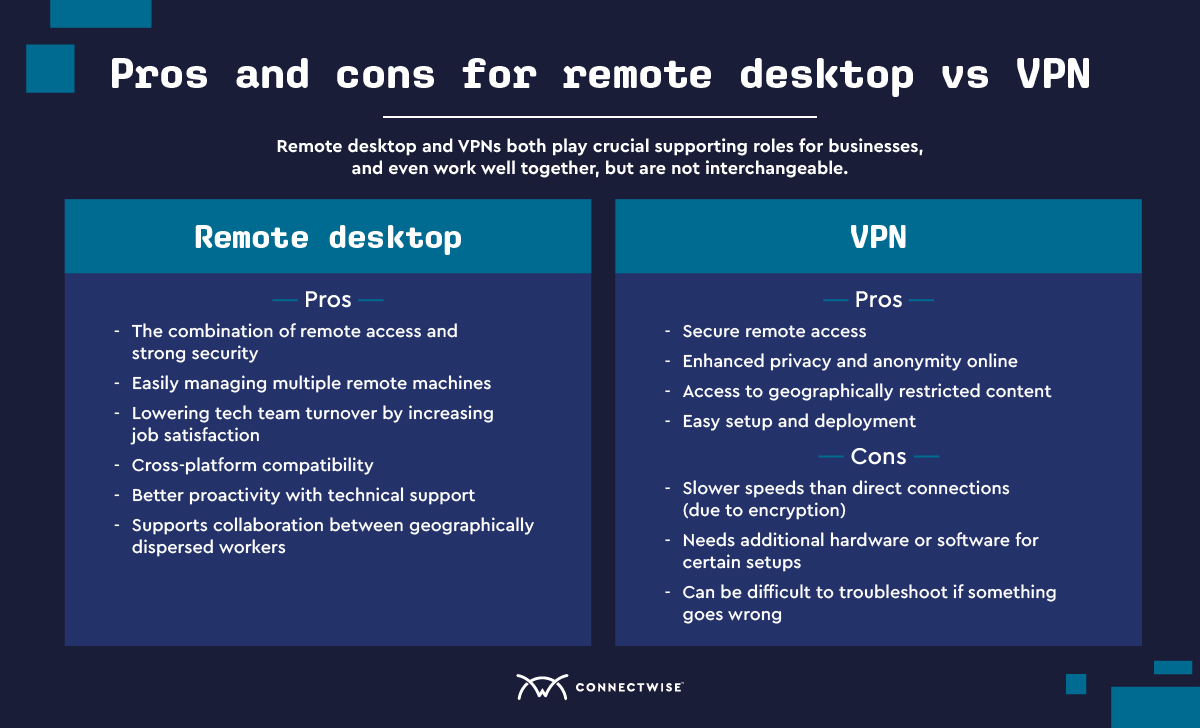Remote desktop vs VPN: what's the difference?
Remote working conditions have undoubtedly changed the landscape of data and technology across the world.
Remote access is becoming increasingly important today as businesses and individuals look to access their data while working remotely securely.
One popular way of providing this kind of secure remote access is through a virtual private network (VPN) or a remote desktop protocol (RDP) connection. However, what’s the difference between these two technologies?
Let’s explore the differences between VPN and remote desktop, discuss their key similarities, and review some considerations when choosing which one is right for you.
How remote desktop supports a business
At its core, remote access software allows for remote support in any organizational setting. Support teams have the capability access different workstations and mobile devices as if they were physically located at the workplace or another location. This allows for faster resolution of any issues as well as less disruption to regular operations. There are also notable cost savings by not having to have support teams onsite at all times.
It's especially beneficial for businesses because it's an efficient way of providing support services. IT technicians can quickly assess any technical issue by connecting to the user’s machine and making the necessary changes without needing to be physically present. This, in turn allows them to be more proactive with their support organization.
In addition, remote desktop software for MSPs can help streamline mundane tasks so employees can focus on higher-value activities.
Finally, by using a remote desktop platform, you address one of the biggest concerns with a remote workforce: security. Remote access software helps secure your data and devices from external threats with a universal standard of support.
Benefits of remote desktop
Remote desktop provides a wide variety of advantages to MSPs, such as:
- The combination of remote access and strong security
- Easily managing multiple remote machines
- Lowering tech team turnover by increasing job satisfaction
- Cross-platform compatibility
- Better proactivity with technical support
- Supports collaboration between geographically dispersed workers
With all the benefits of remote desktop, you want to make sure you are implementing in a secure manner. Ensure your remote desktop tools are safe from cyber threats with our webinar, Intruder Alert: Secure Your Remote Access Tools From Cyberattacks.
How VPNs support a business
A virtual private network (VPN) is another option for providing secure remote access. It creates a private and encrypted connection between two networks, allowing users to access their data while working remotely securely.
A key benefit of using a VPN is the added layer of security it provides by encrypting all traffic going through the tunnel between the two networks, making it much more difficult for malicious hackers to intercept any information being sent or received. This helps protect the user’s data from any potential cyber threats.
In addition, a VPN can provide access to local networks or websites that may not be available in specific locations. This is especially important for businesses operating internationally, as it allows them to easily access resources in other countries without needing to travel there physically.
Pros of VPNs
Using a VPN provides MSPs with many advantages. Here are the pros of VPNs
- Secure remote access
- Enhanced privacy and anonymity online
- Access to geographically restricted content
- Easy setup and deployment
Cons of VPNs
Although there are many benefits to using a VPN, there are some drawbacks that should be taken into consideration:
- Slower speeds than direct connections (due to encryption)
- Needs additional hardware or software for certain setups
- It can be difficult to troubleshoot if something goes wrong

Can you use remote desktop and VPN together?
Fortunately, you can use remote desktop and VPNs together. Using both technologies together can provide maximum security for users accessing resources from different locations.
For example, a user can establish a secure connection over a VPN and then make a remote desktop connection to the same machine. This would provide them with an added layer of protection when accessing sensitive data or applications on the network.
VPN vs RDP: Get the best of both worlds
Ultimately, remote desktop and VPNs can both be used to provide secure remote access to users. In that vein, you can improve your returns by combining both tools.
With ConnectWise Control Access, you can get the best of both worlds. We provide our partners with a secure and reliable way to access remote systems. Control Access integrates remote desktop and VPN technologies into one solution so users can quickly access machines over the internet as if they were in the same room.
Start your free 14-day trial to see first-hand how you can deliver superior service to your customers with ease.